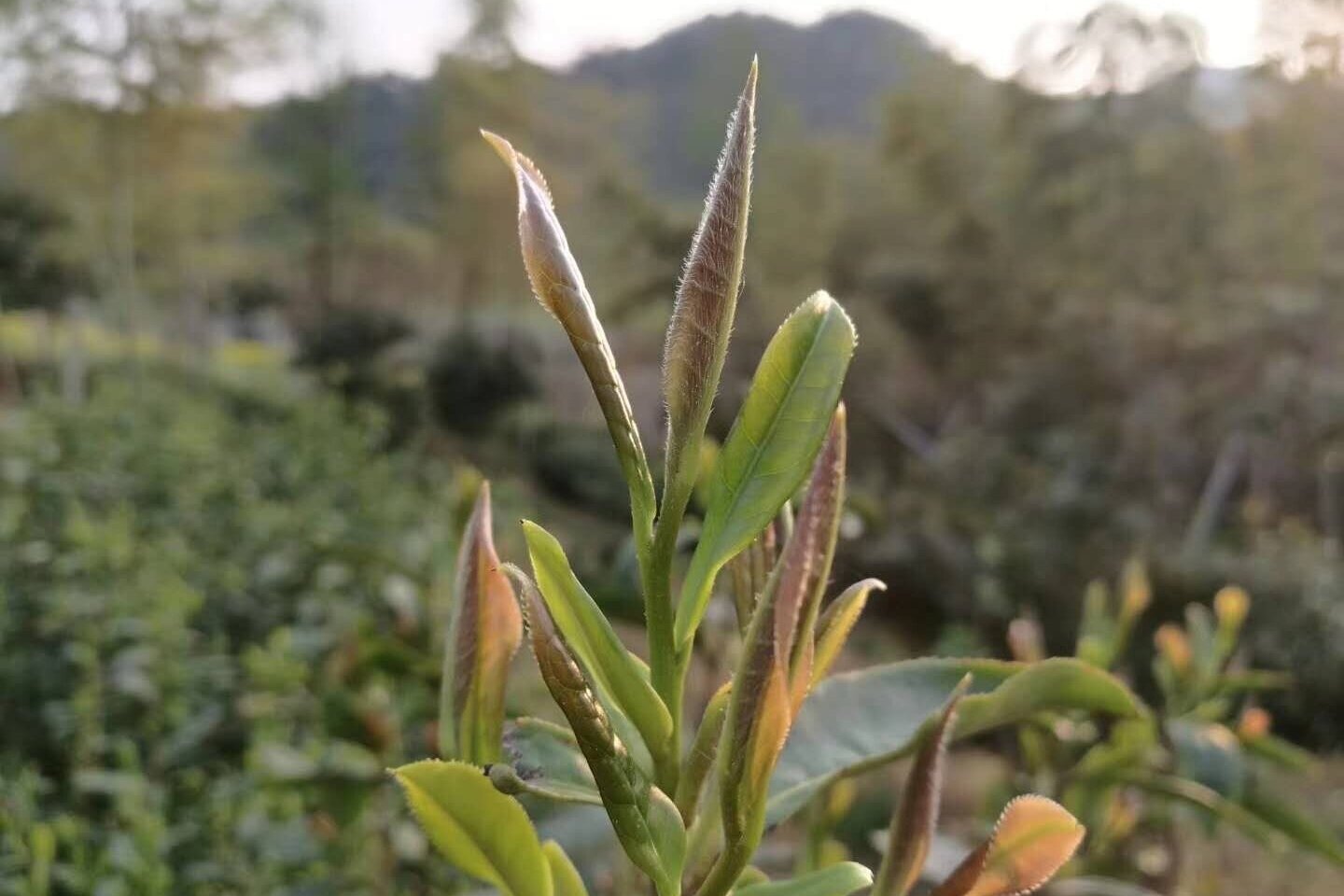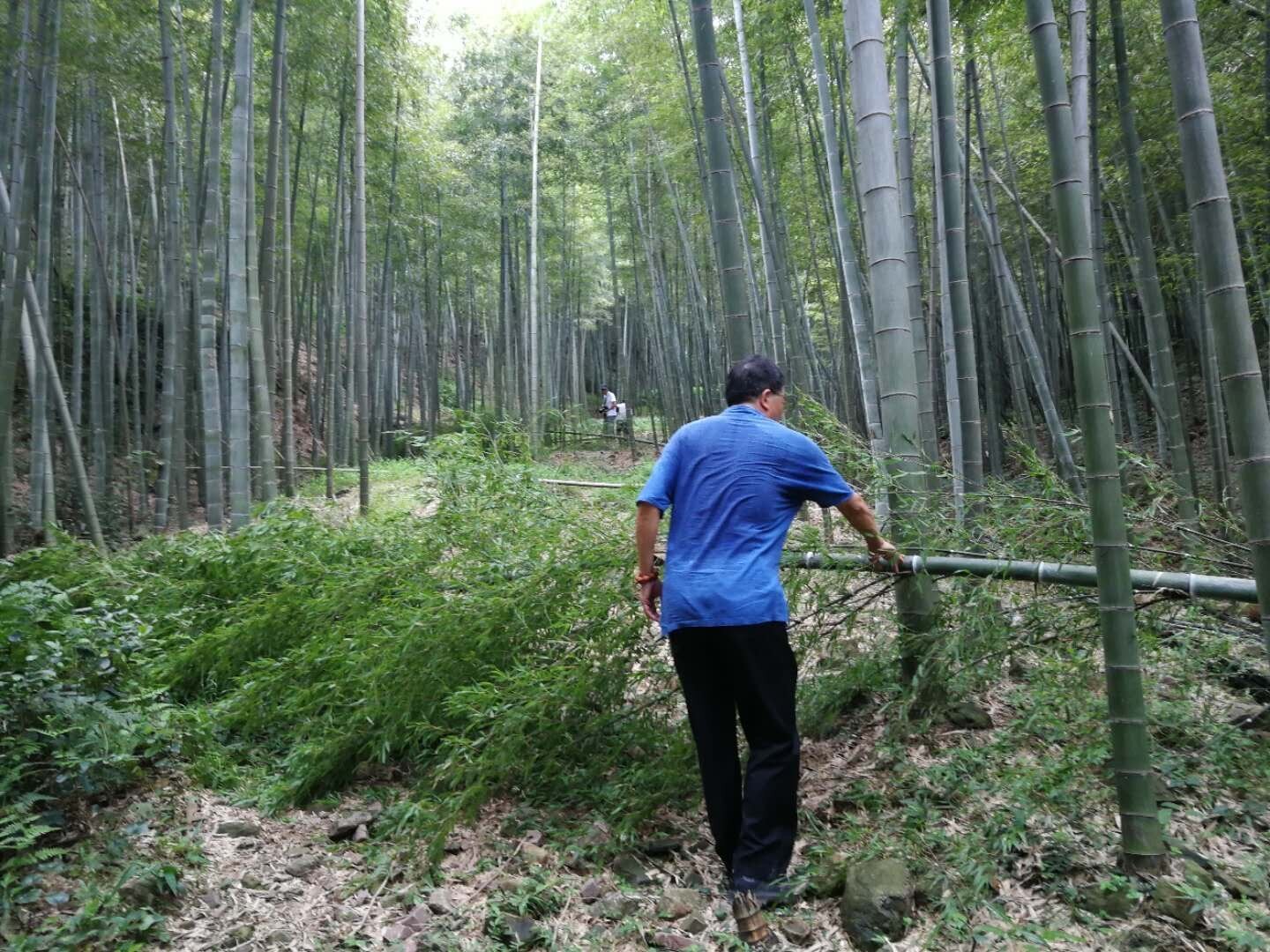GU ZHU PURPLE BAMBOO
by Wenting Zhang
Gu Zhu Purple Bamboo, also known as Gu Zhu Zi Sun (顾诸紫笋), is a green tea originating from Gu Zhu Mountain in Changxing County, Zhejiang, China. Celebrated as a tribute tea with the longest history of fame, and then fell into obscurity. New story continues now.
'Zi' describes the purple color of the young shoots, and 'bamboo' symbolizes the shape of the buds. Surrounded by rolling hills of bamboo forests, it’s no surprise that some think this tea carries a distinct 'bamboo' flavor, cherished by locals as much as the fresh bamboo shoots on their dinner tables when in season. Gu Zhu Purple Bamboo offers a light brew with a noticeable orchid aroma and sweetness. Its savory taste and lingering aftertaste make it a uniquely special green tea among the many available.
Purple shoots of the Gu Zhu Zi Sun, the purple color will slowly disappear while the leave matures.
Branched out from Tian Mu Mountain in the eastern part of China, Tai Lake to its east, Gu Zhu Mountain is hugged on the other three sides by mountains, creating frequent clouds and fogs in the region, an ideal environment for tea with savory notes and less caffeine. The less fortunate part is that it has always been a target during power shifts due to its geographic location. Meanwhile, refugees, immigrants, literals, and hermits had found here a safe haven though, at least temporarily, through the long narrow pathways between different mountains. Locals whose families have lived there since the 19th Century can still point out effortlessly where outside of the area the existing pathways lead. These pathways are called Ka and are used to identify the location of where the tea grows in the region by locals.
Among many who found this to be a safe haven, Lu Yu (733-804 AD) is connected with the story of Purple Bamboo in many ways we have to mention here. He moved the region and spent more than two decades writing “The Classics of Tea”, the first known monograph on tea in the world. In 766 AD, a local official introduced this tea from the monastery on the Gu Zhu Mountain. Captivated by its quality, Lu Yu named it Gu Zhu Zi Sun and recommended it be sent to the imperial court alongside Yang Xian Cha, another tribute tea from Yixing—now more famously known for its Yixing clay teapots favored by tea connoisseurs.
By 770 AD, 30 huts were constructed to ensure the tea was processed to high standards, with Lu Yu overseeing production for a time. Gu Zhu Mountain was designated the Royal Tea Garden, and Gu Zhu Zi Sun remained a tribute tea until 1375 AD, when the Ming Emperor prohibited its production. For a long time in history, the region endured wars and disease, leaving it almost barren.
Chen tried to cross the bamboo just fell down a couple of days ago.
I am very fortunate to have known Chen Ming Lou for over 20 years, ever since I began exploring tea in Shanghai. Regardless of changing tea trends, I always enjoyed visiting his cozy tea hut in the city, where he passionately shared everything about Purple Bamboo. Over time, I learned bits and pieces of his story with this tea.
Chen’s love for tea began in the early 1970s, when state-owned tea shops in China offered a wide variety of teas from across the country. He would purchase a jar of tea, finish it, and then return for a different kind. Everything changed the day he discovered Purple Bamboo. A lover of nature, he began hiking the countless trails around the area, meeting people and delving into historical records. He eventually published a book documenting his journey with Purple Bamboo, sharing the old trials he found, historical facts, and life stories he encountered while enjoying tea with many friends.
I had the privilege of having him guide me on a trip to the region, introducing me his favorite place on earth and the people. Among them, Luo and Jin are two farmers he worked closely with to preserve the traditions of Purple Bamboo.
Luo was telling us that he unconsciously lifted his feet high even walking in the city. A habit growing up in the mountain.
In addition to tea, Luo grows seasonal vegetables such as lily roots and kiwi. He took us to a Ka covered with rocks of various shapes and sizes, and the dense foliage made it tricky to move around. Yet, this environment is exactly what the tea needs. The rocks and foliage help prevent soil erosion, while also maintaining the moisture and temperature levels in the soil.
When I asked, 'How many times a year do you harvest your tea?' he laughed heartily. They only pluck the tea once a year—simply because they don’t have time. He pointed to the teeth marks on the tea seeds and explained, 'Dried tea seeds attract mice. They chew on them, leave them scattered around, and some tea begins to grow wildly as a result.
Jin runs a farm stay while she and her husband take care of the tea, as well as their plum and pear trees, in the mountains. We had a little tea-tasting session in her backyard, which provided a refreshing break from the summer heat. She brought out tables, chairs, and even fans to make us comfortable. Her 90-year-old grandmother and some guests joined us, and the watermelon and locally grown dragon fruit paired surprisingly well with the tea.
Jin’s tea grows on the sloping hills here. The thick layers of bamboo leaves were so slippery that I could barely keep my footing. Imaging picking up tea leaves here!!
Getting down from her tea gardens.
As we ventured deep into the bamboo forests, the rest of the world seemed to often fade completely into the background often after a good 10-minute hike. Only the sounds of cicadas, birds, rustling bamboo leaves, and our footsteps remained...
In those moments, I felt a deep connection to those who had walked this forest long before us. I began to understand why Chan had studied Purple Bamboo for so many decades. A profound sense of peace settled within me, knowing that while some things in life inevitably change—like the story of this tea through history—our connection to the land and its people offers a timeless path to rediscovery and reconnection. It’s much like the signature profile or the ‘bamboo’ note, that Lu Yu once sensed and that we now experience, thanks to people like Chan and his friends.
Summer 2018
Updated: I revisited the region with friends in 2023. Chan accompanied us for almost two weeks, hiking, sharing tea, and meeting people. Last time when I talked with him, he decided to close his tea hut in Shanghai and move to Gu Zhu Mountain.






